Exploring Racism: A Critical Review of Media and Academic Perspectives
VerifiedAdded on 2022/08/23
|10
|2619
|14
Essay
AI Summary
This essay explores the pervasive issue of racism, focusing on its representation in the media and contrasting it with academic research. It begins with an academic literature review, highlighting the historical context and societal impact of racism, particularly in Canada. The review examines how racial prejudice is embedded in institutions and societal attitudes, referencing victim testimonies and media portrayals that reinforce stereotypes. The essay then summarizes media articles discussing racism, including the underrepresentation of racial diversity in Canadian newsrooms and instances of racism against Indigenous communities and Asian communities during the COVID-19 pandemic. A comparative analysis reveals similarities in identifying racial discrimination but notes differences in the depth and robustness of the language used in academic versus media sources. The essay concludes that racism remains a significant global issue, and while Canadian media acknowledges its presence, it often lacks the depth and nuance found in academic discussions, emphasizing the need for continued efforts to combat racism for a more inclusive society. Desklib provides access to this essay and other resources for students.
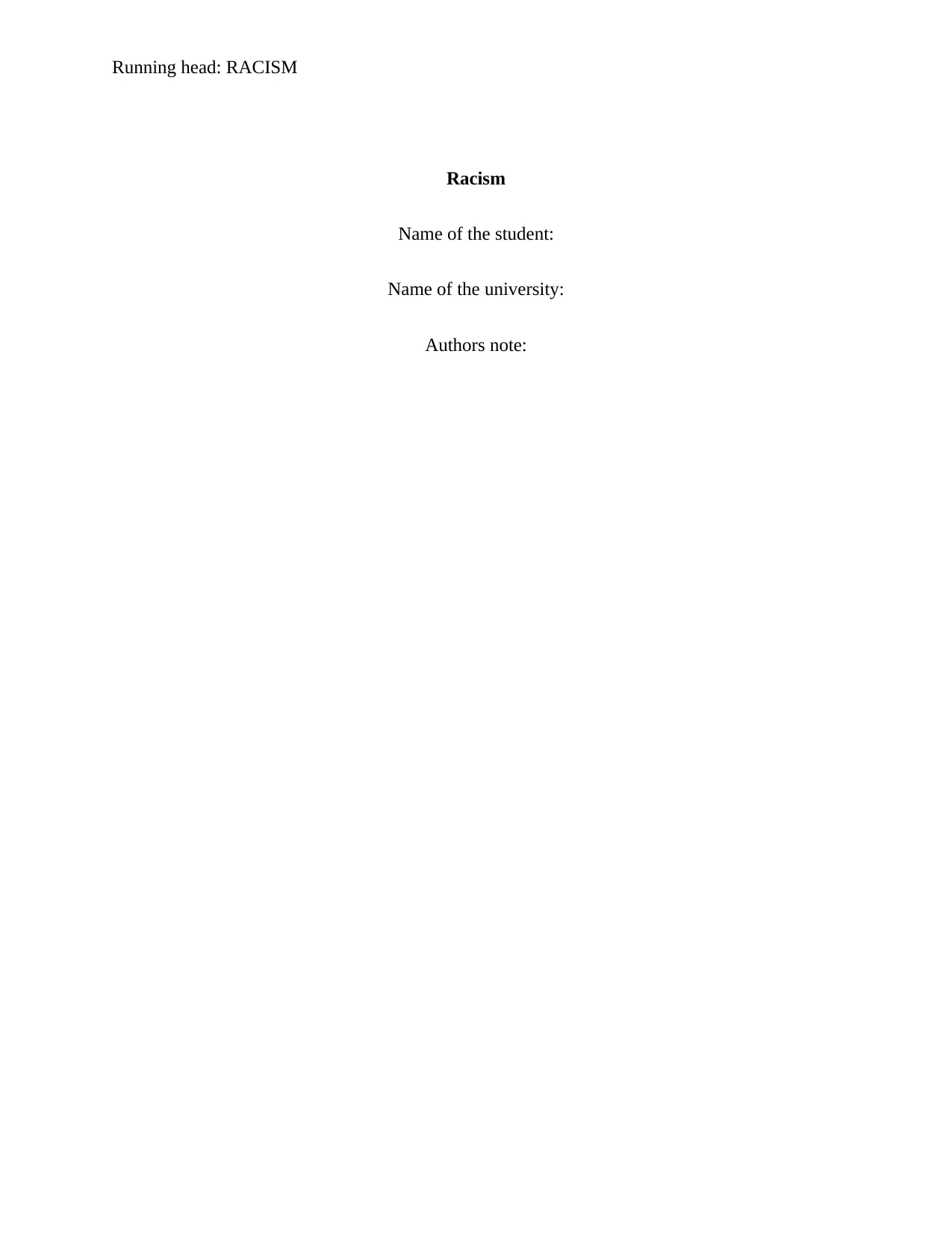
Running head: RACISM
Racism
Name of the student:
Name of the university:
Authors note:
Racism
Name of the student:
Name of the university:
Authors note:
Paraphrase This Document
Need a fresh take? Get an instant paraphrase of this document with our AI Paraphraser
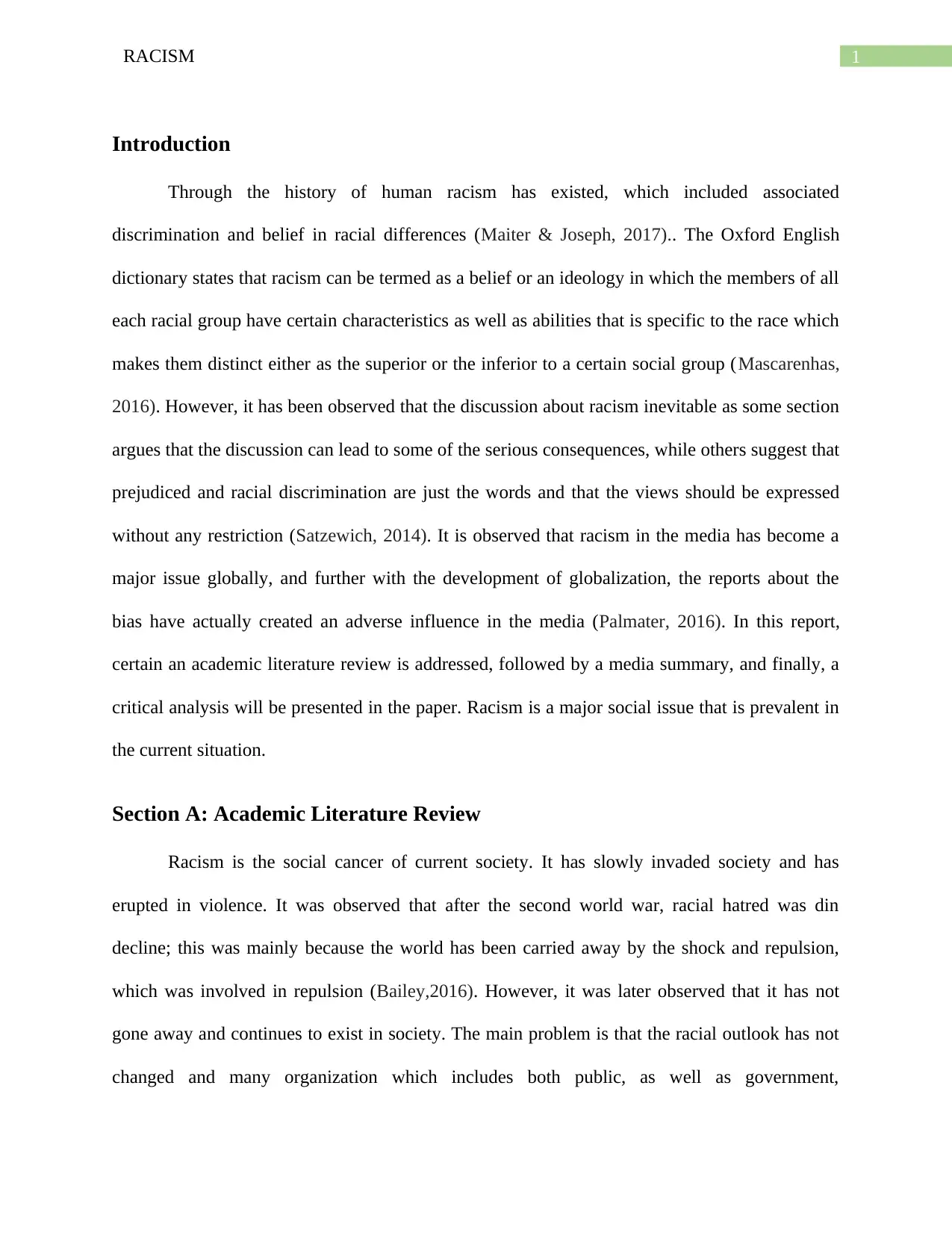
1RACISM
Introduction
Through the history of human racism has existed, which included associated
discrimination and belief in racial differences (Maiter & Joseph, 2017).. The Oxford English
dictionary states that racism can be termed as a belief or an ideology in which the members of all
each racial group have certain characteristics as well as abilities that is specific to the race which
makes them distinct either as the superior or the inferior to a certain social group (Mascarenhas,
2016). However, it has been observed that the discussion about racism inevitable as some section
argues that the discussion can lead to some of the serious consequences, while others suggest that
prejudiced and racial discrimination are just the words and that the views should be expressed
without any restriction (Satzewich, 2014). It is observed that racism in the media has become a
major issue globally, and further with the development of globalization, the reports about the
bias have actually created an adverse influence in the media (Palmater, 2016). In this report,
certain an academic literature review is addressed, followed by a media summary, and finally, a
critical analysis will be presented in the paper. Racism is a major social issue that is prevalent in
the current situation.
Section A: Academic Literature Review
Racism is the social cancer of current society. It has slowly invaded society and has
erupted in violence. It was observed that after the second world war, racial hatred was din
decline; this was mainly because the world has been carried away by the shock and repulsion,
which was involved in repulsion (Bailey,2016). However, it was later observed that it has not
gone away and continues to exist in society. The main problem is that the racial outlook has not
changed and many organization which includes both public, as well as government,
Introduction
Through the history of human racism has existed, which included associated
discrimination and belief in racial differences (Maiter & Joseph, 2017).. The Oxford English
dictionary states that racism can be termed as a belief or an ideology in which the members of all
each racial group have certain characteristics as well as abilities that is specific to the race which
makes them distinct either as the superior or the inferior to a certain social group (Mascarenhas,
2016). However, it has been observed that the discussion about racism inevitable as some section
argues that the discussion can lead to some of the serious consequences, while others suggest that
prejudiced and racial discrimination are just the words and that the views should be expressed
without any restriction (Satzewich, 2014). It is observed that racism in the media has become a
major issue globally, and further with the development of globalization, the reports about the
bias have actually created an adverse influence in the media (Palmater, 2016). In this report,
certain an academic literature review is addressed, followed by a media summary, and finally, a
critical analysis will be presented in the paper. Racism is a major social issue that is prevalent in
the current situation.
Section A: Academic Literature Review
Racism is the social cancer of current society. It has slowly invaded society and has
erupted in violence. It was observed that after the second world war, racial hatred was din
decline; this was mainly because the world has been carried away by the shock and repulsion,
which was involved in repulsion (Bailey,2016). However, it was later observed that it has not
gone away and continues to exist in society. The main problem is that the racial outlook has not
changed and many organization which includes both public, as well as government,
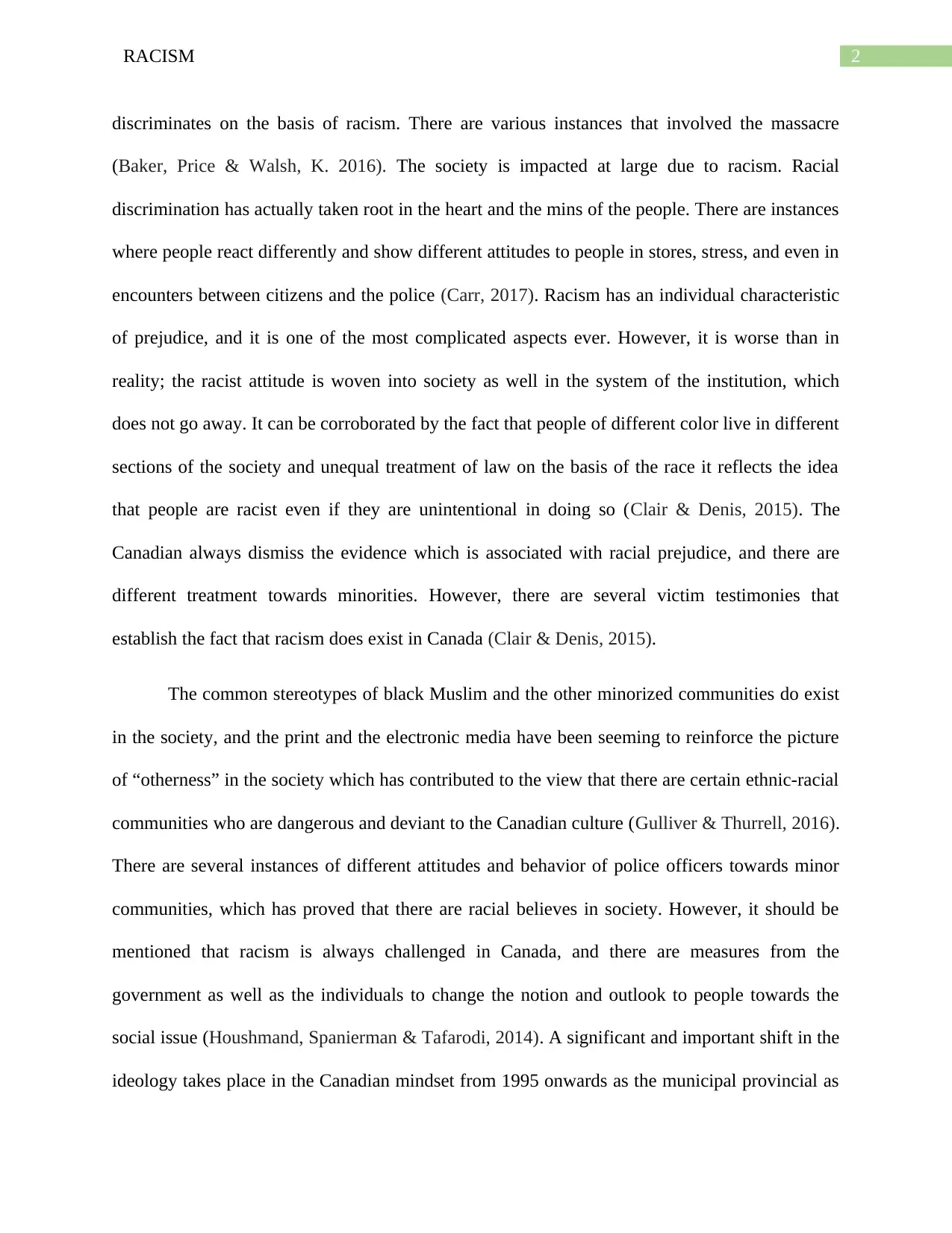
2RACISM
discriminates on the basis of racism. There are various instances that involved the massacre
(Baker, Price & Walsh, K. 2016). The society is impacted at large due to racism. Racial
discrimination has actually taken root in the heart and the mins of the people. There are instances
where people react differently and show different attitudes to people in stores, stress, and even in
encounters between citizens and the police (Carr, 2017). Racism has an individual characteristic
of prejudice, and it is one of the most complicated aspects ever. However, it is worse than in
reality; the racist attitude is woven into society as well in the system of the institution, which
does not go away. It can be corroborated by the fact that people of different color live in different
sections of the society and unequal treatment of law on the basis of the race it reflects the idea
that people are racist even if they are unintentional in doing so (Clair & Denis, 2015). The
Canadian always dismiss the evidence which is associated with racial prejudice, and there are
different treatment towards minorities. However, there are several victim testimonies that
establish the fact that racism does exist in Canada (Clair & Denis, 2015).
The common stereotypes of black Muslim and the other minorized communities do exist
in the society, and the print and the electronic media have been seeming to reinforce the picture
of “otherness” in the society which has contributed to the view that there are certain ethnic-racial
communities who are dangerous and deviant to the Canadian culture (Gulliver & Thurrell, 2016).
There are several instances of different attitudes and behavior of police officers towards minor
communities, which has proved that there are racial believes in society. However, it should be
mentioned that racism is always challenged in Canada, and there are measures from the
government as well as the individuals to change the notion and outlook to people towards the
social issue (Houshmand, Spanierman & Tafarodi, 2014). A significant and important shift in the
ideology takes place in the Canadian mindset from 1995 onwards as the municipal provincial as
discriminates on the basis of racism. There are various instances that involved the massacre
(Baker, Price & Walsh, K. 2016). The society is impacted at large due to racism. Racial
discrimination has actually taken root in the heart and the mins of the people. There are instances
where people react differently and show different attitudes to people in stores, stress, and even in
encounters between citizens and the police (Carr, 2017). Racism has an individual characteristic
of prejudice, and it is one of the most complicated aspects ever. However, it is worse than in
reality; the racist attitude is woven into society as well in the system of the institution, which
does not go away. It can be corroborated by the fact that people of different color live in different
sections of the society and unequal treatment of law on the basis of the race it reflects the idea
that people are racist even if they are unintentional in doing so (Clair & Denis, 2015). The
Canadian always dismiss the evidence which is associated with racial prejudice, and there are
different treatment towards minorities. However, there are several victim testimonies that
establish the fact that racism does exist in Canada (Clair & Denis, 2015).
The common stereotypes of black Muslim and the other minorized communities do exist
in the society, and the print and the electronic media have been seeming to reinforce the picture
of “otherness” in the society which has contributed to the view that there are certain ethnic-racial
communities who are dangerous and deviant to the Canadian culture (Gulliver & Thurrell, 2016).
There are several instances of different attitudes and behavior of police officers towards minor
communities, which has proved that there are racial believes in society. However, it should be
mentioned that racism is always challenged in Canada, and there are measures from the
government as well as the individuals to change the notion and outlook to people towards the
social issue (Houshmand, Spanierman & Tafarodi, 2014). A significant and important shift in the
ideology takes place in the Canadian mindset from 1995 onwards as the municipal provincial as
⊘ This is a preview!⊘
Do you want full access?
Subscribe today to unlock all pages.

Trusted by 1+ million students worldwide
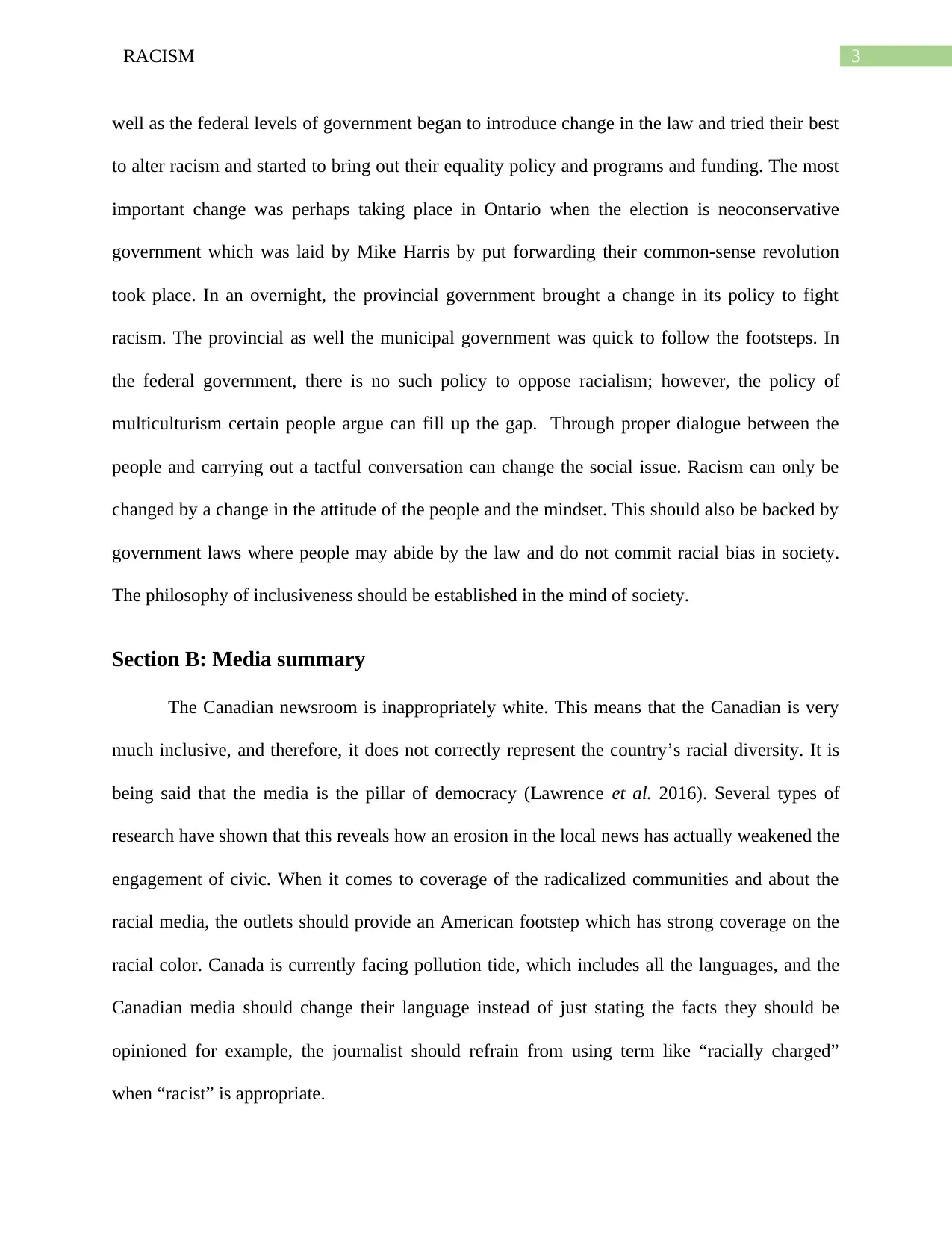
3RACISM
well as the federal levels of government began to introduce change in the law and tried their best
to alter racism and started to bring out their equality policy and programs and funding. The most
important change was perhaps taking place in Ontario when the election is neoconservative
government which was laid by Mike Harris by put forwarding their common-sense revolution
took place. In an overnight, the provincial government brought a change in its policy to fight
racism. The provincial as well the municipal government was quick to follow the footsteps. In
the federal government, there is no such policy to oppose racialism; however, the policy of
multiculturism certain people argue can fill up the gap. Through proper dialogue between the
people and carrying out a tactful conversation can change the social issue. Racism can only be
changed by a change in the attitude of the people and the mindset. This should also be backed by
government laws where people may abide by the law and do not commit racial bias in society.
The philosophy of inclusiveness should be established in the mind of society.
Section B: Media summary
The Canadian newsroom is inappropriately white. This means that the Canadian is very
much inclusive, and therefore, it does not correctly represent the country’s racial diversity. It is
being said that the media is the pillar of democracy (Lawrence et al. 2016). Several types of
research have shown that this reveals how an erosion in the local news has actually weakened the
engagement of civic. When it comes to coverage of the radicalized communities and about the
racial media, the outlets should provide an American footstep which has strong coverage on the
racial color. Canada is currently facing pollution tide, which includes all the languages, and the
Canadian media should change their language instead of just stating the facts they should be
opinioned for example, the journalist should refrain from using term like “racially charged”
when “racist” is appropriate.
well as the federal levels of government began to introduce change in the law and tried their best
to alter racism and started to bring out their equality policy and programs and funding. The most
important change was perhaps taking place in Ontario when the election is neoconservative
government which was laid by Mike Harris by put forwarding their common-sense revolution
took place. In an overnight, the provincial government brought a change in its policy to fight
racism. The provincial as well the municipal government was quick to follow the footsteps. In
the federal government, there is no such policy to oppose racialism; however, the policy of
multiculturism certain people argue can fill up the gap. Through proper dialogue between the
people and carrying out a tactful conversation can change the social issue. Racism can only be
changed by a change in the attitude of the people and the mindset. This should also be backed by
government laws where people may abide by the law and do not commit racial bias in society.
The philosophy of inclusiveness should be established in the mind of society.
Section B: Media summary
The Canadian newsroom is inappropriately white. This means that the Canadian is very
much inclusive, and therefore, it does not correctly represent the country’s racial diversity. It is
being said that the media is the pillar of democracy (Lawrence et al. 2016). Several types of
research have shown that this reveals how an erosion in the local news has actually weakened the
engagement of civic. When it comes to coverage of the radicalized communities and about the
racial media, the outlets should provide an American footstep which has strong coverage on the
racial color. Canada is currently facing pollution tide, which includes all the languages, and the
Canadian media should change their language instead of just stating the facts they should be
opinioned for example, the journalist should refrain from using term like “racially charged”
when “racist” is appropriate.
Paraphrase This Document
Need a fresh take? Get an instant paraphrase of this document with our AI Paraphraser
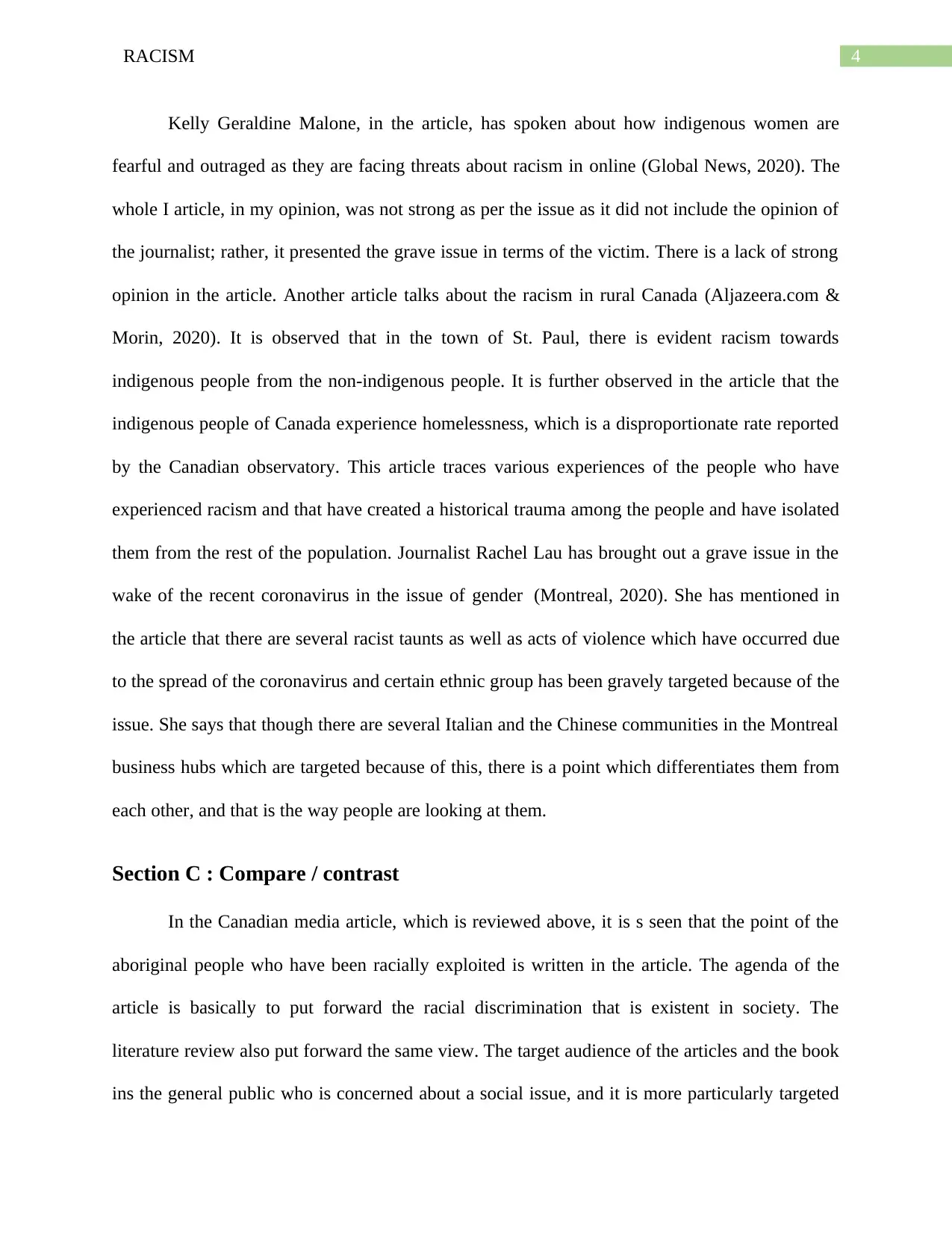
4RACISM
Kelly Geraldine Malone, in the article, has spoken about how indigenous women are
fearful and outraged as they are facing threats about racism in online (Global News, 2020). The
whole I article, in my opinion, was not strong as per the issue as it did not include the opinion of
the journalist; rather, it presented the grave issue in terms of the victim. There is a lack of strong
opinion in the article. Another article talks about the racism in rural Canada (Aljazeera.com &
Morin, 2020). It is observed that in the town of St. Paul, there is evident racism towards
indigenous people from the non-indigenous people. It is further observed in the article that the
indigenous people of Canada experience homelessness, which is a disproportionate rate reported
by the Canadian observatory. This article traces various experiences of the people who have
experienced racism and that have created a historical trauma among the people and have isolated
them from the rest of the population. Journalist Rachel Lau has brought out a grave issue in the
wake of the recent coronavirus in the issue of gender (Montreal, 2020). She has mentioned in
the article that there are several racist taunts as well as acts of violence which have occurred due
to the spread of the coronavirus and certain ethnic group has been gravely targeted because of the
issue. She says that though there are several Italian and the Chinese communities in the Montreal
business hubs which are targeted because of this, there is a point which differentiates them from
each other, and that is the way people are looking at them.
Section C : Compare / contrast
In the Canadian media article, which is reviewed above, it is s seen that the point of the
aboriginal people who have been racially exploited is written in the article. The agenda of the
article is basically to put forward the racial discrimination that is existent in society. The
literature review also put forward the same view. The target audience of the articles and the book
ins the general public who is concerned about a social issue, and it is more particularly targeted
Kelly Geraldine Malone, in the article, has spoken about how indigenous women are
fearful and outraged as they are facing threats about racism in online (Global News, 2020). The
whole I article, in my opinion, was not strong as per the issue as it did not include the opinion of
the journalist; rather, it presented the grave issue in terms of the victim. There is a lack of strong
opinion in the article. Another article talks about the racism in rural Canada (Aljazeera.com &
Morin, 2020). It is observed that in the town of St. Paul, there is evident racism towards
indigenous people from the non-indigenous people. It is further observed in the article that the
indigenous people of Canada experience homelessness, which is a disproportionate rate reported
by the Canadian observatory. This article traces various experiences of the people who have
experienced racism and that have created a historical trauma among the people and have isolated
them from the rest of the population. Journalist Rachel Lau has brought out a grave issue in the
wake of the recent coronavirus in the issue of gender (Montreal, 2020). She has mentioned in
the article that there are several racist taunts as well as acts of violence which have occurred due
to the spread of the coronavirus and certain ethnic group has been gravely targeted because of the
issue. She says that though there are several Italian and the Chinese communities in the Montreal
business hubs which are targeted because of this, there is a point which differentiates them from
each other, and that is the way people are looking at them.
Section C : Compare / contrast
In the Canadian media article, which is reviewed above, it is s seen that the point of the
aboriginal people who have been racially exploited is written in the article. The agenda of the
article is basically to put forward the racial discrimination that is existent in society. The
literature review also put forward the same view. The target audience of the articles and the book
ins the general public who is concerned about a social issue, and it is more particularly targeted
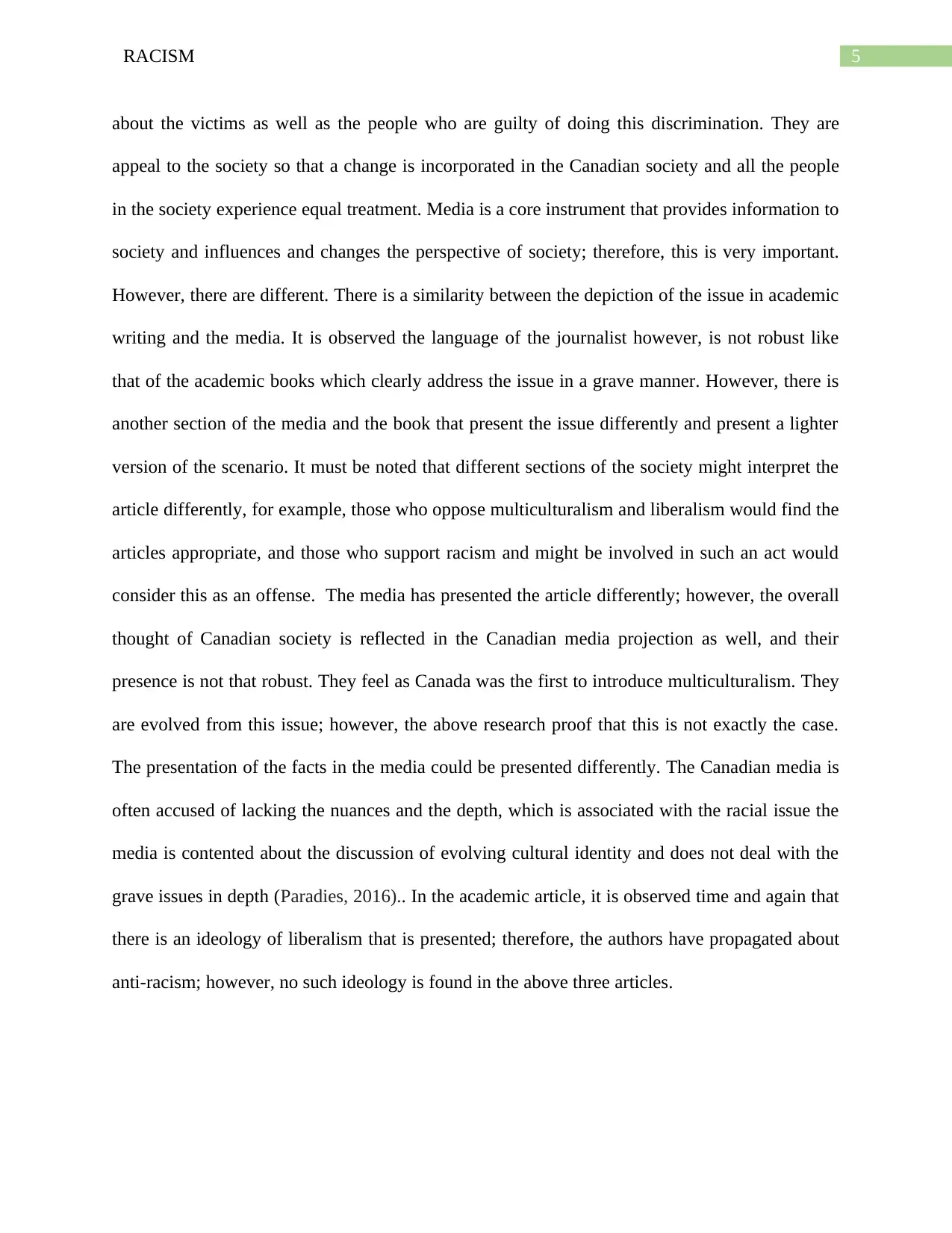
5RACISM
about the victims as well as the people who are guilty of doing this discrimination. They are
appeal to the society so that a change is incorporated in the Canadian society and all the people
in the society experience equal treatment. Media is a core instrument that provides information to
society and influences and changes the perspective of society; therefore, this is very important.
However, there are different. There is a similarity between the depiction of the issue in academic
writing and the media. It is observed the language of the journalist however, is not robust like
that of the academic books which clearly address the issue in a grave manner. However, there is
another section of the media and the book that present the issue differently and present a lighter
version of the scenario. It must be noted that different sections of the society might interpret the
article differently, for example, those who oppose multiculturalism and liberalism would find the
articles appropriate, and those who support racism and might be involved in such an act would
consider this as an offense. The media has presented the article differently; however, the overall
thought of Canadian society is reflected in the Canadian media projection as well, and their
presence is not that robust. They feel as Canada was the first to introduce multiculturalism. They
are evolved from this issue; however, the above research proof that this is not exactly the case.
The presentation of the facts in the media could be presented differently. The Canadian media is
often accused of lacking the nuances and the depth, which is associated with the racial issue the
media is contented about the discussion of evolving cultural identity and does not deal with the
grave issues in depth (Paradies, 2016).. In the academic article, it is observed time and again that
there is an ideology of liberalism that is presented; therefore, the authors have propagated about
anti-racism; however, no such ideology is found in the above three articles.
about the victims as well as the people who are guilty of doing this discrimination. They are
appeal to the society so that a change is incorporated in the Canadian society and all the people
in the society experience equal treatment. Media is a core instrument that provides information to
society and influences and changes the perspective of society; therefore, this is very important.
However, there are different. There is a similarity between the depiction of the issue in academic
writing and the media. It is observed the language of the journalist however, is not robust like
that of the academic books which clearly address the issue in a grave manner. However, there is
another section of the media and the book that present the issue differently and present a lighter
version of the scenario. It must be noted that different sections of the society might interpret the
article differently, for example, those who oppose multiculturalism and liberalism would find the
articles appropriate, and those who support racism and might be involved in such an act would
consider this as an offense. The media has presented the article differently; however, the overall
thought of Canadian society is reflected in the Canadian media projection as well, and their
presence is not that robust. They feel as Canada was the first to introduce multiculturalism. They
are evolved from this issue; however, the above research proof that this is not exactly the case.
The presentation of the facts in the media could be presented differently. The Canadian media is
often accused of lacking the nuances and the depth, which is associated with the racial issue the
media is contented about the discussion of evolving cultural identity and does not deal with the
grave issues in depth (Paradies, 2016).. In the academic article, it is observed time and again that
there is an ideology of liberalism that is presented; therefore, the authors have propagated about
anti-racism; however, no such ideology is found in the above three articles.
⊘ This is a preview!⊘
Do you want full access?
Subscribe today to unlock all pages.

Trusted by 1+ million students worldwide
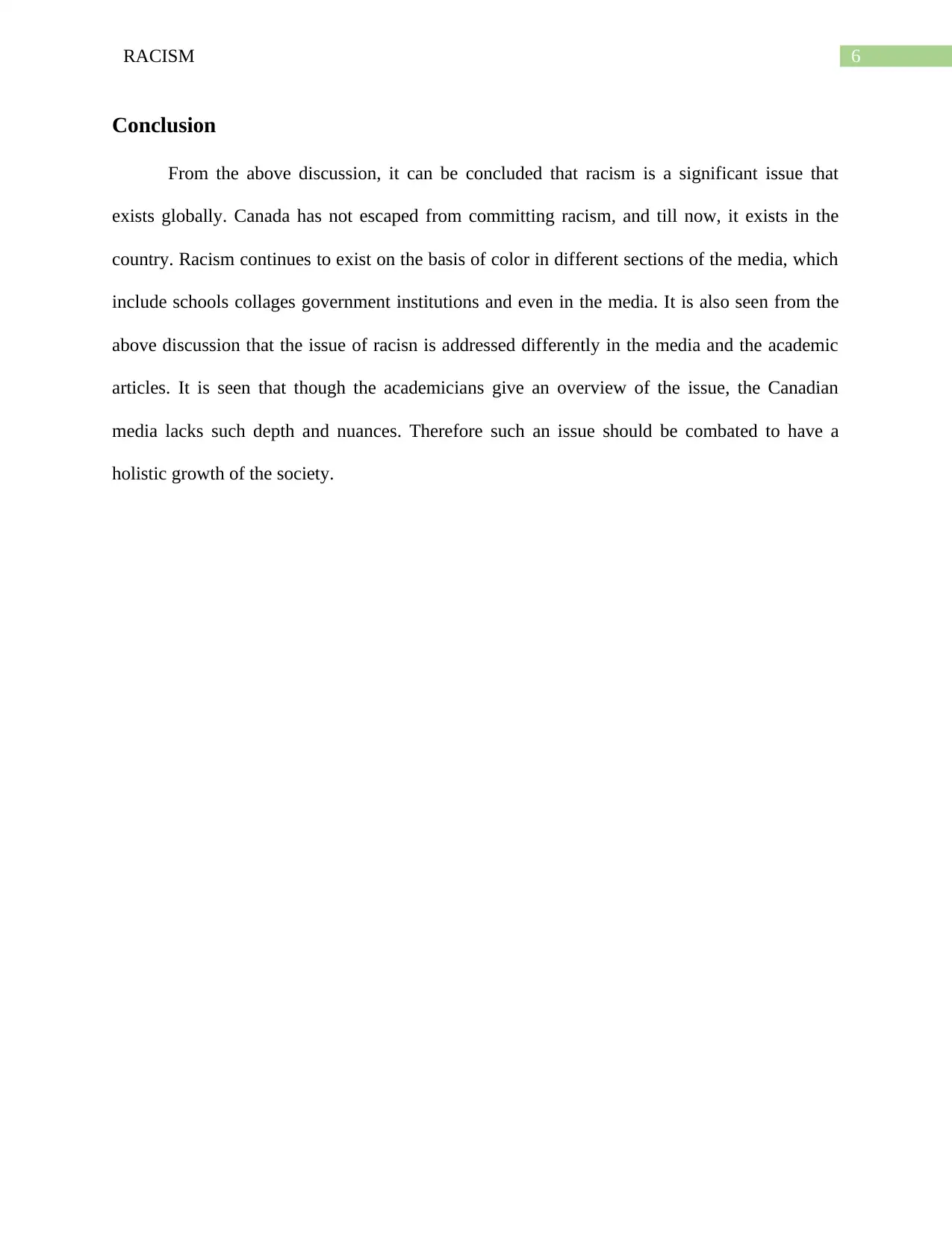
6RACISM
Conclusion
From the above discussion, it can be concluded that racism is a significant issue that
exists globally. Canada has not escaped from committing racism, and till now, it exists in the
country. Racism continues to exist on the basis of color in different sections of the media, which
include schools collages government institutions and even in the media. It is also seen from the
above discussion that the issue of racisn is addressed differently in the media and the academic
articles. It is seen that though the academicians give an overview of the issue, the Canadian
media lacks such depth and nuances. Therefore such an issue should be combated to have a
holistic growth of the society.
Conclusion
From the above discussion, it can be concluded that racism is a significant issue that
exists globally. Canada has not escaped from committing racism, and till now, it exists in the
country. Racism continues to exist on the basis of color in different sections of the media, which
include schools collages government institutions and even in the media. It is also seen from the
above discussion that the issue of racisn is addressed differently in the media and the academic
articles. It is seen that though the academicians give an overview of the issue, the Canadian
media lacks such depth and nuances. Therefore such an issue should be combated to have a
holistic growth of the society.
Paraphrase This Document
Need a fresh take? Get an instant paraphrase of this document with our AI Paraphraser
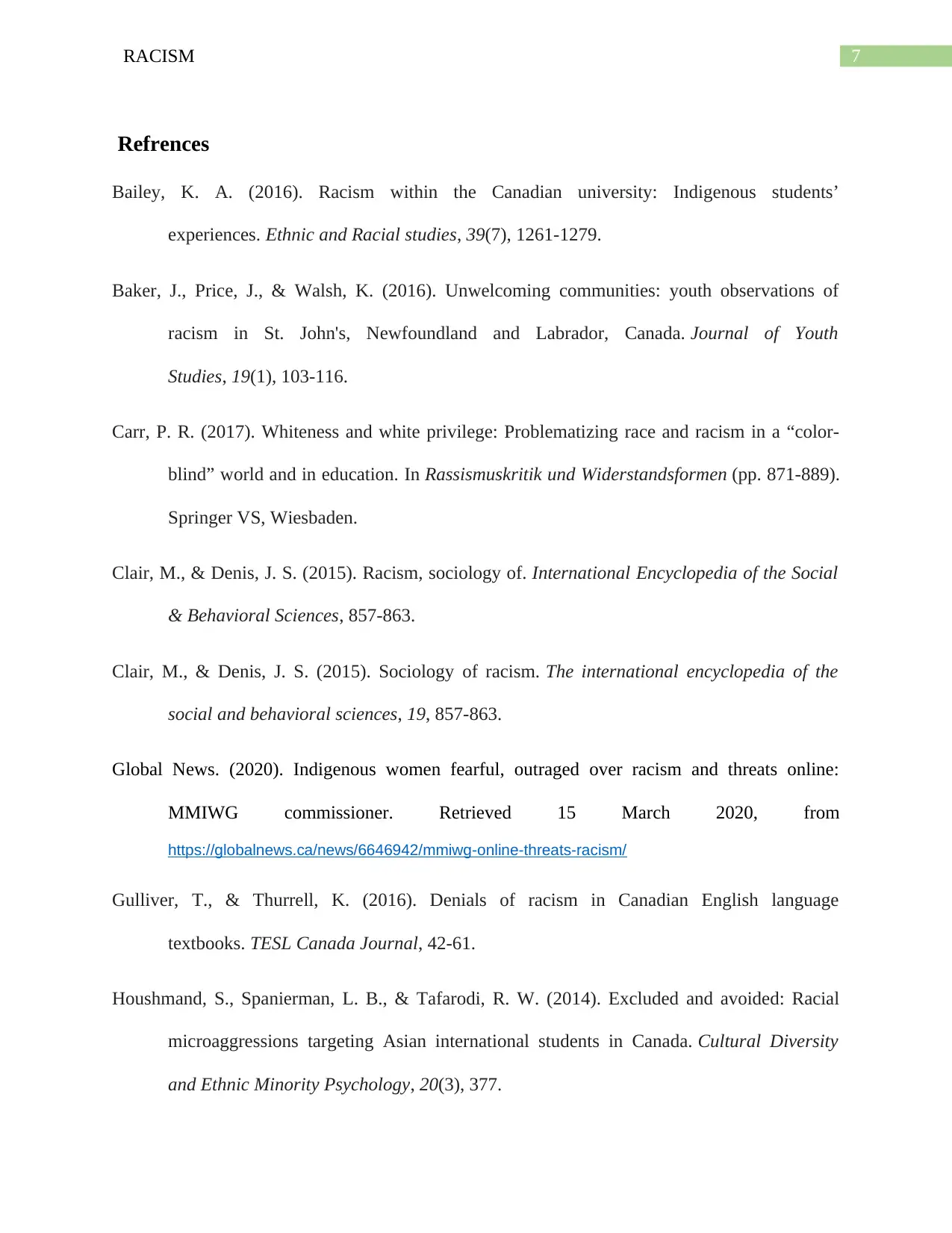
7RACISM
Refrences
Bailey, K. A. (2016). Racism within the Canadian university: Indigenous students’
experiences. Ethnic and Racial studies, 39(7), 1261-1279.
Baker, J., Price, J., & Walsh, K. (2016). Unwelcoming communities: youth observations of
racism in St. John's, Newfoundland and Labrador, Canada. Journal of Youth
Studies, 19(1), 103-116.
Carr, P. R. (2017). Whiteness and white privilege: Problematizing race and racism in a “color-
blind” world and in education. In Rassismuskritik und Widerstandsformen (pp. 871-889).
Springer VS, Wiesbaden.
Clair, M., & Denis, J. S. (2015). Racism, sociology of. International Encyclopedia of the Social
& Behavioral Sciences, 857-863.
Clair, M., & Denis, J. S. (2015). Sociology of racism. The international encyclopedia of the
social and behavioral sciences, 19, 857-863.
Global News. (2020). Indigenous women fearful, outraged over racism and threats online:
MMIWG commissioner. Retrieved 15 March 2020, from
https://globalnews.ca/news/6646942/mmiwg-online-threats-racism/
Gulliver, T., & Thurrell, K. (2016). Denials of racism in Canadian English language
textbooks. TESL Canada Journal, 42-61.
Houshmand, S., Spanierman, L. B., & Tafarodi, R. W. (2014). Excluded and avoided: Racial
microaggressions targeting Asian international students in Canada. Cultural Diversity
and Ethnic Minority Psychology, 20(3), 377.
Refrences
Bailey, K. A. (2016). Racism within the Canadian university: Indigenous students’
experiences. Ethnic and Racial studies, 39(7), 1261-1279.
Baker, J., Price, J., & Walsh, K. (2016). Unwelcoming communities: youth observations of
racism in St. John's, Newfoundland and Labrador, Canada. Journal of Youth
Studies, 19(1), 103-116.
Carr, P. R. (2017). Whiteness and white privilege: Problematizing race and racism in a “color-
blind” world and in education. In Rassismuskritik und Widerstandsformen (pp. 871-889).
Springer VS, Wiesbaden.
Clair, M., & Denis, J. S. (2015). Racism, sociology of. International Encyclopedia of the Social
& Behavioral Sciences, 857-863.
Clair, M., & Denis, J. S. (2015). Sociology of racism. The international encyclopedia of the
social and behavioral sciences, 19, 857-863.
Global News. (2020). Indigenous women fearful, outraged over racism and threats online:
MMIWG commissioner. Retrieved 15 March 2020, from
https://globalnews.ca/news/6646942/mmiwg-online-threats-racism/
Gulliver, T., & Thurrell, K. (2016). Denials of racism in Canadian English language
textbooks. TESL Canada Journal, 42-61.
Houshmand, S., Spanierman, L. B., & Tafarodi, R. W. (2014). Excluded and avoided: Racial
microaggressions targeting Asian international students in Canada. Cultural Diversity
and Ethnic Minority Psychology, 20(3), 377.
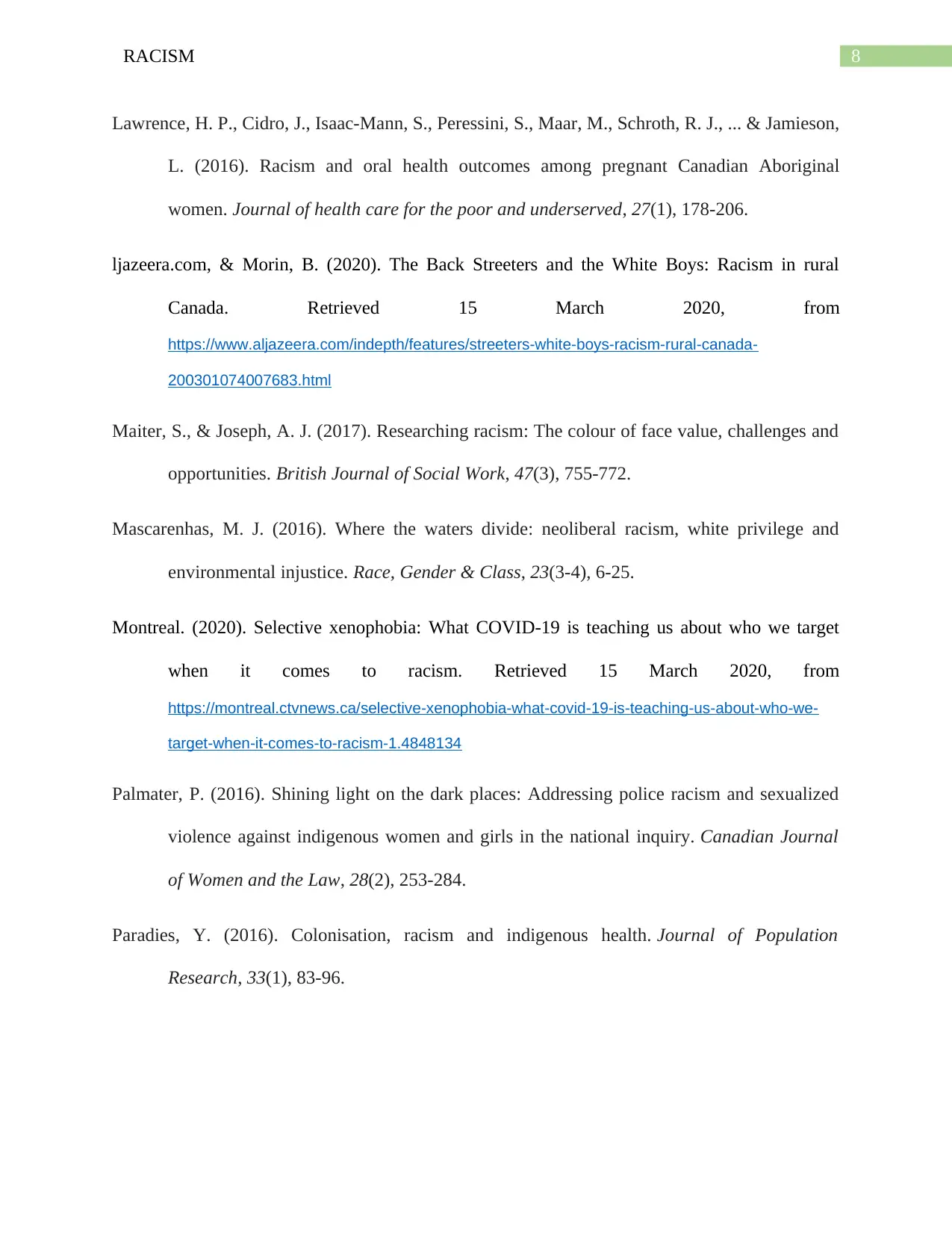
8RACISM
Lawrence, H. P., Cidro, J., Isaac-Mann, S., Peressini, S., Maar, M., Schroth, R. J., ... & Jamieson,
L. (2016). Racism and oral health outcomes among pregnant Canadian Aboriginal
women. Journal of health care for the poor and underserved, 27(1), 178-206.
ljazeera.com, & Morin, B. (2020). The Back Streeters and the White Boys: Racism in rural
Canada. Retrieved 15 March 2020, from
https://www.aljazeera.com/indepth/features/streeters-white-boys-racism-rural-canada-
200301074007683.html
Maiter, S., & Joseph, A. J. (2017). Researching racism: The colour of face value, challenges and
opportunities. British Journal of Social Work, 47(3), 755-772.
Mascarenhas, M. J. (2016). Where the waters divide: neoliberal racism, white privilege and
environmental injustice. Race, Gender & Class, 23(3-4), 6-25.
Montreal. (2020). Selective xenophobia: What COVID-19 is teaching us about who we target
when it comes to racism. Retrieved 15 March 2020, from
https://montreal.ctvnews.ca/selective-xenophobia-what-covid-19-is-teaching-us-about-who-we-
target-when-it-comes-to-racism-1.4848134
Palmater, P. (2016). Shining light on the dark places: Addressing police racism and sexualized
violence against indigenous women and girls in the national inquiry. Canadian Journal
of Women and the Law, 28(2), 253-284.
Paradies, Y. (2016). Colonisation, racism and indigenous health. Journal of Population
Research, 33(1), 83-96.
Lawrence, H. P., Cidro, J., Isaac-Mann, S., Peressini, S., Maar, M., Schroth, R. J., ... & Jamieson,
L. (2016). Racism and oral health outcomes among pregnant Canadian Aboriginal
women. Journal of health care for the poor and underserved, 27(1), 178-206.
ljazeera.com, & Morin, B. (2020). The Back Streeters and the White Boys: Racism in rural
Canada. Retrieved 15 March 2020, from
https://www.aljazeera.com/indepth/features/streeters-white-boys-racism-rural-canada-
200301074007683.html
Maiter, S., & Joseph, A. J. (2017). Researching racism: The colour of face value, challenges and
opportunities. British Journal of Social Work, 47(3), 755-772.
Mascarenhas, M. J. (2016). Where the waters divide: neoliberal racism, white privilege and
environmental injustice. Race, Gender & Class, 23(3-4), 6-25.
Montreal. (2020). Selective xenophobia: What COVID-19 is teaching us about who we target
when it comes to racism. Retrieved 15 March 2020, from
https://montreal.ctvnews.ca/selective-xenophobia-what-covid-19-is-teaching-us-about-who-we-
target-when-it-comes-to-racism-1.4848134
Palmater, P. (2016). Shining light on the dark places: Addressing police racism and sexualized
violence against indigenous women and girls in the national inquiry. Canadian Journal
of Women and the Law, 28(2), 253-284.
Paradies, Y. (2016). Colonisation, racism and indigenous health. Journal of Population
Research, 33(1), 83-96.
⊘ This is a preview!⊘
Do you want full access?
Subscribe today to unlock all pages.

Trusted by 1+ million students worldwide
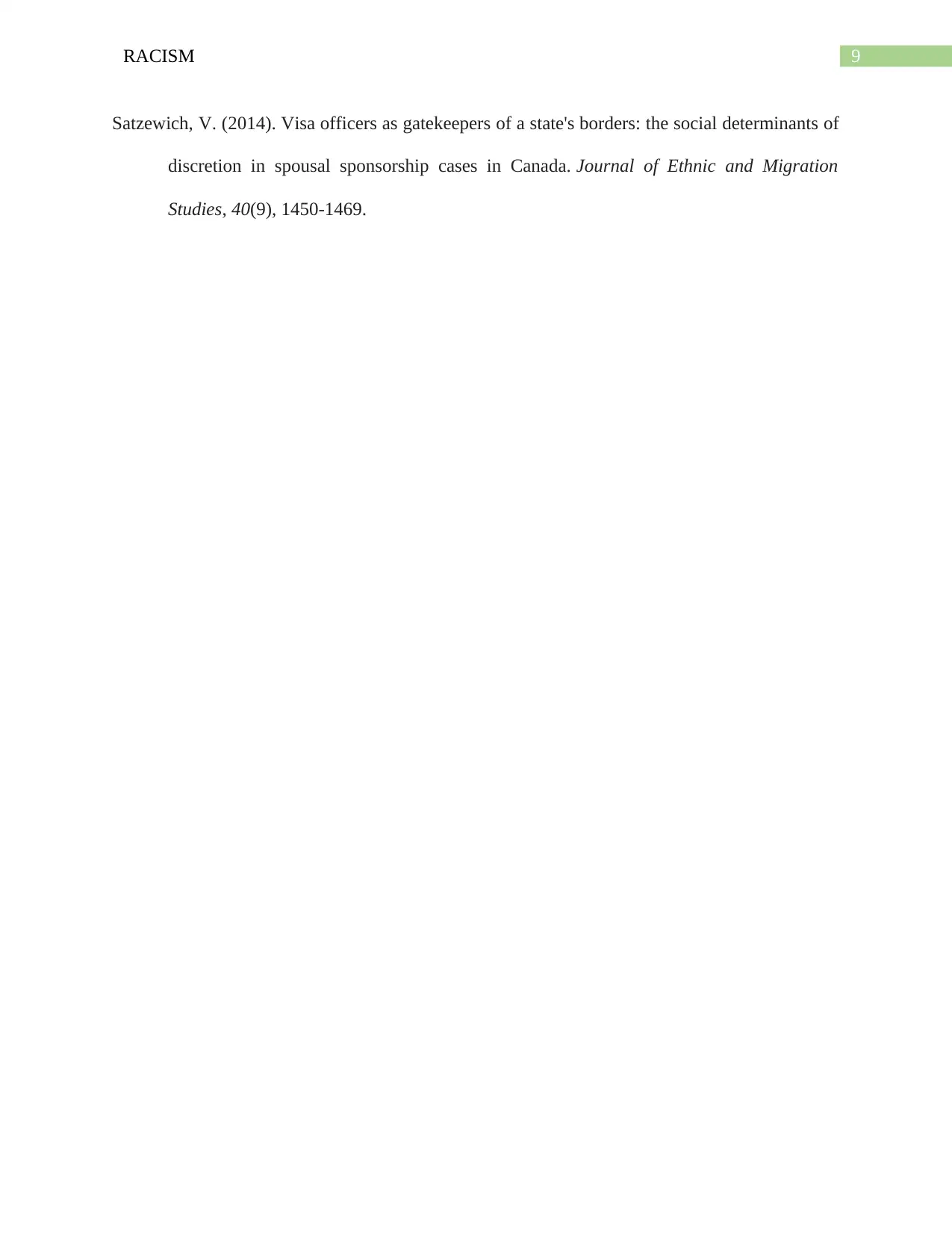
9RACISM
Satzewich, V. (2014). Visa officers as gatekeepers of a state's borders: the social determinants of
discretion in spousal sponsorship cases in Canada. Journal of Ethnic and Migration
Studies, 40(9), 1450-1469.
Satzewich, V. (2014). Visa officers as gatekeepers of a state's borders: the social determinants of
discretion in spousal sponsorship cases in Canada. Journal of Ethnic and Migration
Studies, 40(9), 1450-1469.
1 out of 10
Related Documents
Your All-in-One AI-Powered Toolkit for Academic Success.
+13062052269
info@desklib.com
Available 24*7 on WhatsApp / Email
![[object Object]](/_next/static/media/star-bottom.7253800d.svg)
Unlock your academic potential
Copyright © 2020–2025 A2Z Services. All Rights Reserved. Developed and managed by ZUCOL.





